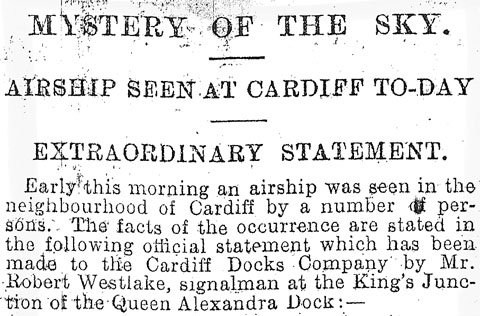Starting tomorrow, I’m going to try some more post-blogging. It’s 100 years since the phantom airship wave of 1909, when mysterious aerial visitors appeared in the night skies over Britain. Or at least, stories about mysterious aerial visitors filled the newspapers of Britain. It’s hard to tell from this distance: the only evidence we have about the scareships are the press reports, which could be a problem if you are interested in a possible underlying reality. But then again, since the number of (alleged) phantom airship witnesses is relatively small, the press was the only way most people would have learned that their sky was being invaded by Zeppelins every night. So for them as for us, the stories are the event itself. (The phantom airship scare did not take place, perhaps?)
My sources are a variety of print periodicals: The Times, the Liberal Manchester Guardian (much more Radical than it was later), the Globe and Traveller and the Standard (both from London and both Conservative, or Unionist if you prefer), Saturday Review (Conservative, but not as reactionary as under Lady Houston), Fortnightly Review, Punch, the local weeklies Norfolk News, Eastern Counties Journal, and Norwich, Yarmouth, and Lynn Commercial Gazette (which I’ll refer to as the Norfolk News!) and Southampton Times and Hampshire Express, and the specialist weekly Flight. At this time there was no radio and film was a novelty.
Compared with the Sudeten crisis twenty-nine years later, the 1909 airship scare was not as intense nor was it as protracted. It was not a major defence or political crisis. But it was about the first time that the possibility of an aerial threat to Britain was given an extended run in the press, even if that threat was not yet the knock-out blow …
Further reading: Alfred Gollin, The Impact of Air Power on the British People and their Government, 1909-14 (Stanford: Stanford University Press, 1989); David Clarke, ‘Scareships over Britain: the airship wave of 1909’, Fortean Studies 6 (1999), 39-63; Nigel Watson, ‘Airships and invaders. Background to a social panic’, Magonia 3 (Spring 1980).
![]() This work is licensed under a Creative Commons Attribution-NonCommercial-NoDerivatives 4.0 International License.
Permissions beyond the scope of this license may be available at http://airminded.org/copyright/.
This work is licensed under a Creative Commons Attribution-NonCommercial-NoDerivatives 4.0 International License.
Permissions beyond the scope of this license may be available at http://airminded.org/copyright/.



Pingback: Postblogging 1909 « The Edge of the American West
Yeah, 2009-1909 = 100, not 90!
Unfortunately, 1909 was the last expedition that MASSA (Martian Aetheric Space Survey Agency) could mount using airships because of the rapid destruction of the aether due to the spread of Einsteinian relativity. It wasn’t until 1947 that saucer technology was sufficiently advanced to resume exploration.
Actually, it was lamas from Mu.
Yay, now I don’t have to have an opinion about high art! (Picasso –he’s the one who draws just like Bill Amend, and “Hiroshima, Mon Amour,” –it has subtitles?)
Actually, mystery aircraft (including balloons) seem to have first appeared around about the early 1890s, so maybe it was the Michelson-Morley experiment which causes the aether to deteriorate …
Brett, the whole post-blogging idea is new to me, but I love how it’s working out in this series. Do many history-related blogs try this approach? Fascinating way to present the airship material.
Thanks, Paul. It’s not a common approach — but see David Silbey on the Boxer Uprising and Ross Mahoney on the Mareth Line. There are quite a few primary source blogs out there, which republish entries from diaries or letters day by day (e.g. by George Orwell) but “post-blogging” is more synthetic and more discursive than this approach allows.
Pingback: [links] Link salad has a slow morning | jlake.com
Pingback: There Will Be Zeppelins
Pingback: Links at Mother’s Cupboard » Notes from dissertopia